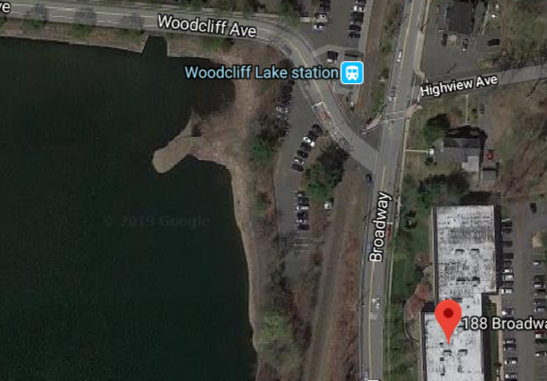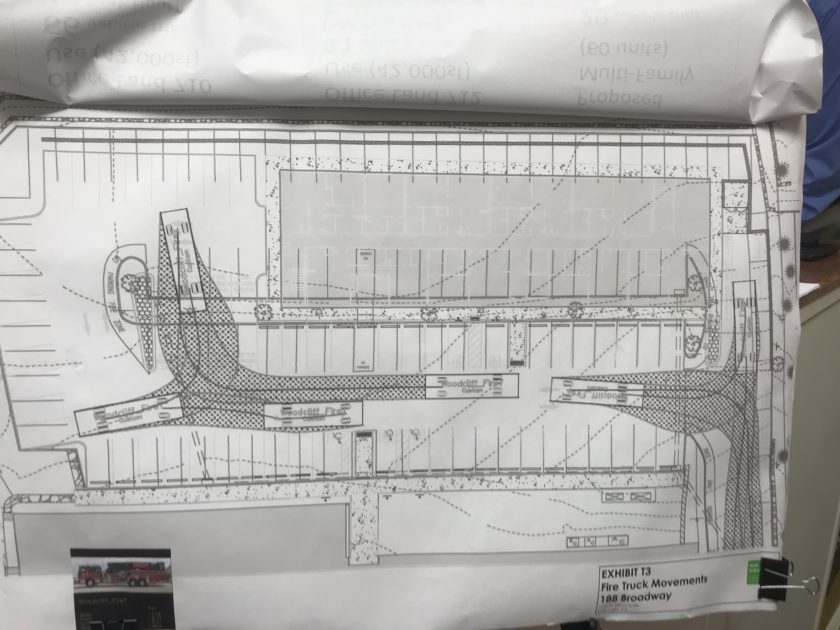
WOODCLIFF LAKE, N.J.—Some of the five “special reasons” the applicant planner cites for approving a use variance for a proposed 60-unit, two building multifamily housing complex at 188 Broadway may not be special enough to qualify it for Zoning Board approval.
That’s according to a borough planning consultant speaking June 25 at a second consecutive four-hour-plus meeting on the contentious proposal.
Approximately 40 residents jammed the borough’s municipal chamber June 25, anticipating it to be a final meeting with non-restricted public questions and comments and a final vote.
Due to extensive testimony and questions, the hearing was continued to July 23 at 7:30 p.m. at Borough Hall.
The complex is proposed to include nine affordable units, due to a borough ordinance mandating a 15% affordable housing set-aside in multifamily developments of five or more units.
The use variance requested is to construct 60 apartments and permit multi-family residential use in an S-O zone, or Special Office Zone.
Additional variances to construct a three-story building and a variance for deficient interior parking lot landscaping are also requested.
The consultant said that although he could point out history, context and possible inconsistencies in the applicant’s planning rationale and special reasons, the decision on evaluating whether each special reason is valid for the use variance request is up to board members.
Borough Planning Consultant Richard Preiss went through the five special reasons applicant planner Joseph Burgis cited on June 4 detailing why the proposed the two-building complex—which needs a use variance for the site to build multifamily housing—may or may not qualify for such a variance based on reasons Burgis previously elaborated on.
Ten to 15 residents who signed up to speak on the proposal, plus questions from Zoning Board board professionals and board members, a closing statement by the applicant attorney, and statements from board members on their votes may be likely July 23.
Residents also are concerned about effects on local schools, traffic, density, borough services, and emergency access.
Throughout six hearings, members of local anti-development group Woodcliff Lake SHINE have attended, wearing “SOD” stickers, standing for Stop Overdevelopment.

Are these special uses?
Preiss told Zoning Board members that he wasn’t sure the proposal met the special criteria for advancing the purposes of local land use law—nor did the proposal help the borough meet its affordable housing obligations as the project’s proposal was submitted followed the approval of the affordable housing settlement plan.
In addition, Preiss said, the settlement agreement specifically excludes the Broadway Corridor south of Highview Avenue from affordable housing overlay zoning.
He said the proposal’s nine affordable housing units were “a benefit” to meeting future affordable housing “unmet need” but are not required in the settlement.
Priess said Fair Share Housing Center agreed to exclude Broadway Corridor south of Highview Avenue from the settlement plan.
“No overlay zones were required or adopted to meet the [affordable housing] unmet need on the Broadway Corridor south of Highview and I just think the board needs to know that history,” Preiss said.
He said the borough settlement would not be affected by not approving affordable housing on the site.
He later told Delia that because the nine affordable housing units were not in a 100% affordable complex they did not qualify as an “inherently beneficial use” in town.
He said the nine affordable units in an “inclusionary development” of 60 rental units were mandated by the set-aside requirement in the town’s newly adopted Housing Element and Fair Share Plan ordinance.
Preiss said the principles of smart growth were furthered by the high density residential transit-oriented development near a train station.
He said a mixed-use project would be better but a residential development still furthers smart growth principles. He said state definitions of smart growth include compact, walkable, environmentally sustainable and offering a variety of housing.
He said he doubted “furthering the state plan’s goals” qualified as a special reason as most towns in Bergen County fall in the state’s planning region, although the applicant’s transit-oriented development was helpful.
He said although the site was “far from being unique it does have the imprimatur of the state plan.”
He said the applicant’s special reason to approve the project—allegedly that it would generate less traffic than would an office development (the site is zoned S-O or special office zone) it was likelier that the project simply would not “have a substantial negative impact” on traffic.
He questioned whether the applicant could legitimately say the proposed development “reduced” traffic.
Delia questioned Preiss about what zoning was valid as the borough’s Master Plan had not been updated in 10 years, as required by law.
Preiss later noted that the last fully updated Master Plan was completed in 2008, which was still in effect when the 188 Broadway application was filed in 2018.
The Master Plan is now over 10 years old and technically outdated, said Preiss, though periodic Master Plan re-examinations were done, as were several Broadway Corridor studies in 2017 and 2018.

Office use ‘infeasible’?
Preiss also noted that no applicant testimony was offered to support whether it was “infeasible” to maintain the 188 Broadway site as an office complex or if a concerted marketing effort existed for the office building to advertise for possible occupants.
Delia questioned Preiss on his explanations challenging some “special reasons” for approval of a use variance.
A few sharp exchanges occurred when Delia questioned Preiss’s observations and tried to make comparisons with other projects in town.
When a resident asked Preiss for his opinion on whether the site was “particularly suited” for its requested use variance, he said “I think I’ve made my testimony clear. It’s up to the board to make its own decision.”
Borough traffic engineer Brian Intindola said the busy multi-signal intersection at Broadway and Woodcliff Avenue was “not a totally unusual intersection for Bergen County.”
He said that the proposed residential development—versus the previous office complex—would lead to seven more left-hand turns over a one-hour peak period in the morning and eight additional left-hand turns into the site during an evening peak traffic period.
Intindola suggested approaching Bergen County to install a “do not block” box striped area to allow cars to turn into or out of the development’s driveway as one possible solution when traffic backs up at nearby lights.
He said most motorists obey the box most of the time. Delia said the applicant would request such a turning area from the county.

Residents have their say
Some six residents took advantage of their time to speak before the meeting adjourned at 11:35 p.m.
Some disputed traffic counts, questioning how a multifamily development could create less traffic despite testimony from both the applicant and borough traffic engineers on traffic volumes being less with a residential development versus an office building.
Resident Craig Marson presented a 36-page document alleging the application was “rife with conflict.” Before he got far with this, Zoning Board attorney Sal Princiotto directed him to limit his public comments to the proposal.
Marson wrote, “I believe the project is terribly flawed, driven solely by profit, unfit for the area and should be rejected outright.”
Cheryl Dispoto said it was “disingenuous” for the applicant to say the proposal helps the borough meet its affordable housing obligations.
“We’re already building what is legally required and satisfying our Fair Share obligations,” she said. She added, “We do not need these additional units…residents are tired of hearing from developers in this state and in Pascack Valley to overdevelop.”
Dispoto said the applicant never intended to provide affordable units until they were informed of the borough affordable set-aside ordinance.
July 23 meeeting one to watch
On July 23, expect remaining speakers to provide a no-holds-barred perspective on the proposal.
Previously, the public was restricted to asking questions on specific testimony provided by applicant or borough experts.
During final comments, residents are allowed to offer opinions on any aspect of the development in a five-minute period.
Affordable housing announcement
The borough has affordable housing units available for sale periodically and is accepting applications. The housing is available for qualified low- and moderate-income households and is located at Centennial Way.
The housing includes two and three bedroom townhome units. Households will be required to submit an application and income documentation in order to qualify.
For applications, visit the borough website.
